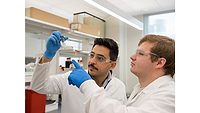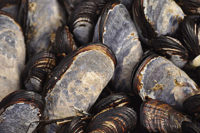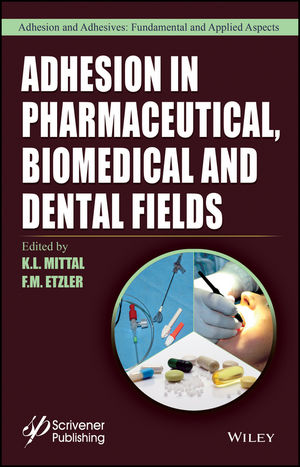Mussels-Inspired Injectable Bioglue Seals Surgical Wounds
Researchers develop biodegradable hydrogel adhesive for sealing internal soft-tissue incisions using inspiration from nature.

Maxvis / iStock / Getty Images Plus via Getty Images
A UCLA-led research team has created a new, biodegradable hydrogel adhesive that is reported to be three-times stronger than comparable bioglues. Injected from a syringe, the bioglue’s honey-like viscosity coupled with its fast-sealing action could improve precision in closing surgical wounds on curved and wet tissues. The new glue, which contains more than 80% water, was inspired by the way that mussels adhere themselves to rocks, pier pilings, and other wet surfaces.
Suturing and stapling are standard techniques to close surgical wounds, but these methods are inefficient for sealing internal soft-tissue incisions such as those on the heart, lung, and bladder tissues. Even the current best surgical adhesives are runny when first applied, making them difficult to control. They also take a long time to set and can cause unwanted adhesion due to dripping.
To address these challenges, a team of researchers looked to mussels commonly found along the coastlines for inspiration. These shellbound molluscs anchor themselves to wet surfaces by secreting highly sticky foot proteins composed of chemical compounds called catechols. These organic compounds enable mussels to stay attached to surfaces in wet conditions, making it a promising material for improved surgical glues.
“Modification of natural biomaterials with catechols has been pursued previously. However, the majority of these modifications were limited by low yield for adequate tissue adhesion,” said study leader Paul Weiss, a distinguished professor of chemistry and biochemistry at UCLA. “In our study, we demonstrated a chemical\modification route that boosts the amount of catechol functionality that one can introduce to natural biomaterials such as gelatin, which is a favorable candidate for us due to its superior biocompatibility and biodegradability.” Weiss also holds faculty appointments in bioengineering, and materials science and engineering at the UCLA Samueli School of Engineering.

UCLA-led team demonstrates its biodegradable and tunable surgical adhesive inspired by mussels and applicable to wet tissues.
The bioglue’s tunable thickness, or viscosity, and rapid solidification make it easier to control for precise injection, allowing it to seal wet wounds and to stop bleeding rapidly. The thermo-sensitive glue can be removed safely, if needed, by reducing its stickiness through controlling the temperature applied to the glue. Made of gelatin and caffeic acid (found in coffee, tea, or wine), the natural glue also demonstrates antioxidant properties, aiding the healing process after surgical procedure.
“While gelatin by itself can work as a biodegradable, nontoxic surgical adhesive, its low viscosity at body temperature means that it can be quite runny, spilling over into places that do not need an adhesive,” said study first author and bioengineering doctoral student Hossein Montazerian. “In this study, we fine-tuned the processing parameters to optimize the amount of catechol — striking the right balance between viscosity and increased adhesion while also satisfying clinical requirements.”
Montazerian is advised by Weiss, who is also a member of the California NanoSystems Institute at UCLA and holds the UC Presidential Chair in Chemistry, and co-corresponding author Nasim Annabi, a chemical and biomolecular engineering assistant professor who also has a faculty appointment in bioengineering. The research was part of a continuing collaboration with co-corresponding author Ali Khademhosseini, CEO of the Terasaki Institute for Biomedical Innovation and a former UCLA professor of bioengineering, chemical and biomolecular engineering, and radiology. Other authors on the paper are Elham Davoodi, Alireza Hassani Najafabadi and Reihaneh Haghniaz of the Terasaki Institute.
A study describing the bioglue was published in the open-access journal Cell Reports Physical Sciences.
Looking for a reprint of this article?
From high-res PDFs to custom plaques, order your copy today!






